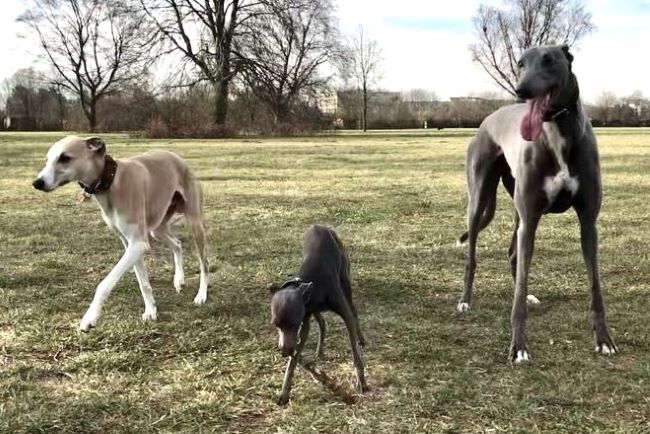Greyhounds generally come in three sizes: small, medium, and large. These categorizations are based on the dog’s weight and height. Depending on those dimensions, the greyhound may be classified as small (25 to 40 pounds), medium (40 to 60 pounds), or large (60 to 85 pounds).
Small Greyhounds
Small greyhounds, also known as Italian Greyhounds, are the smallest variation of this breed. They typically weigh between 25 to 40 pounds and stand about 13 to 15 inches tall at the shoulder. Even though they are small, they still possess the notable characteristics of greyhounds: high energy, speed, and a sleek body.
Here are some common traits of small greyhounds:
- Their small size makes them perfect for apartment or city living.
- They have a playful temperament, making them family- and pet-friendly.
- They need less food due to their smaller size.
- Despite their smaller size, they still need regular exercise.
Medium Greyhounds
Medium-sized greyhounds generally weigh between 40 to 60 pounds and stand about 15 to 20 inches tall. They continue the Greyhound’s tradition of being known for speed and agility but remain a manageable size for all sorts of living situations.
Traits often attributed to medium greyhounds include:
- They are often considered the “Goldilocks” size— just right for many potential owners.
- Their needs for exercise can typically be met with a daily walk and some off-leash time in a secure area.
- They can comfortably live in many types of homes, from apartments to larger houses.
- They continue to be slender dogs, minimizing spatial requirements despite their size.
Large Greyhounds
Large greyhounds are what many people have in mind when they think of this breed. They usually weigh between 60 to 85 pounds and stand between 25 to 30 inches tall. They are an athletic and energetic breed, known for their incredible speed and natural hunting instincts.
Here are a few characteristics of large greyhounds:
- They typically require more exercise than their smaller counterparts.
- Their size means they may not be suitable for small apartments or homes without access to outdoor space.
- Due to their hunting instincts, they often benefit from engagement in activities such as lure coursing.
- Despite their size, they are often quite calm and gentle dogs.
Additionally, the table below summarizes the sizes of greyhounds:
| Greyhound Size | Weight Range (pounds) | Height Range (inches) |
| Small | 25-40 | 13-15 |
| Medium | 40-60 | 15-20 |
| Large | 60-85 | 25-30 |
This thorough break-down ensures a clear understanding of the categorizations and characteristics of the greyhound’s sizes.
Historical Background of Greyhounds’ Sizes
Greyhound history is one of the oldest among dog breeds, dating back several thousand years. The breed’s development has targeted a combination of speed, endurance, and hunting ability that resulted in a lean and athletic physique. The size of these dogs was based on the specific tasks they were bred for. Large greyhounds were used for hunting large game such as deer, whereas smaller greyhounds were used for chasing smaller game.
Over the years, the raising and breeding of greyhounds have led to the distinct variations in size we now recognize: small, medium, and large.
Size and Speed
Greyhounds’ sizes directly correlate to their speed. Interestingly, the larger the greyhound, the faster they’re likely to be. Large greyhounds, despite their size, can achieve a top speed of around 45 miles per hour, making them one of the fastest dog breeds on earth.
Medium and small greyhounds, while not hitting these top speeds, still possess significant agility and speed, even outperforming several other dog breeds. When you pick a greyhound, irrespective of the size, you’re choosing a companion that can exhilarate you with its speed and energy.
Size and Health
The size of a greyhound can also influence its overall health. Larger greyhounds may experience more joint issues such as hip dysplasia because of the added pressure on their skeletal structure. Meanwhile, smaller greyhounds, especially Italian Greyhounds, are susceptible to dental problems due to their small mouths.
While the health problems are not directly a consequence of their size and genetics plays a significant role, understanding these tendencies connected to the sizes can help potential owners be proactive in ensuring their greyhounds are healthy.
Size in Greyhound Racing
Greyhound racing has been a popular sport for over a century. The size of the dog plays a crucial role in their racing efficacy. Generally, larger greyhounds are preferred in racing due to their long strides and exceptional speed. However, smaller and medium-sized greyhounds also participate and can excel in this sport due to their quick launch and agility.
Frequently Asked Questions about Greyhound Sizes
Can the size of a greyhound determine its lifespan?
A: Not directly, but there’s a general rule in dog breeds where smaller breeds tend to live longer than larger ones. However, greyhounds, even the large ones, are typically quite healthy and can live between 10-14 years on average.
How quickly do greyhounds grow to their full size?
A: Most greyhounds reach their adult size by the time they’re about 18 months old. However, weight can still fluctuate during the first two years, so don’t be surprised if your greyhound fills out a bit after reaching its adult height.
How can I tell what size my greyhound puppy is going to be?
A: You can estimate the future size by looking at the parent dogs and considering the breed standards. However, exact predictions can be tricky since genetics and environmental factors both play a role.
Why are there size differences within the greyhound breed?
A: Greyhounds were bred for hunting and racing, requiring different characteristics that were achieved partially through size. Smaller dogs were used for chasing smaller game, while larger greyhounds were utilized for larger game and for racing.
Are smaller greyhounds less energetic?
A: No. Despite their smaller size, Italian Greyhounds (small greyhounds) are still quite energetic and agile. They enjoy daily walks, playing, and sprinting in a safe, fenced area – just like their larger counterparts.
How does the size of a greyhound affect its diet?
A: The larger the greyhound, the more calories they typically need to sustain their energy levels. However, each greyhound is an individual, so dietary needs can vary based on factors like age, health, and activity level.
Is there any difference in the coats or colors between different sized greyhounds?
A: No. Coat thickness and color are not impacted by the size of the greyhound. All greyhounds have short, smooth coats that come in a wide variety of colors and patterns.
Can I determine the size of my greyhound by its paw size?
A: While paw size can give a rough indication, it is not a reliable predictor of a puppy’s final size. Genetics play the largest role, so looking at the parent dogs, if possible, will provide a better clue.
Do larger greyhounds need more exercise?
A: All greyhounds need regular exercise, regardless of their size. However, larger greyhounds might enjoy a bit more physical activity, given their athletic build and racing lineage.
Are larger greyhounds more difficult to train?
A: No. The trainability of a greyhound is not significantly impacted by its size. Greyhounds, regardless of their size, are known for their intelligence which aids in training.




